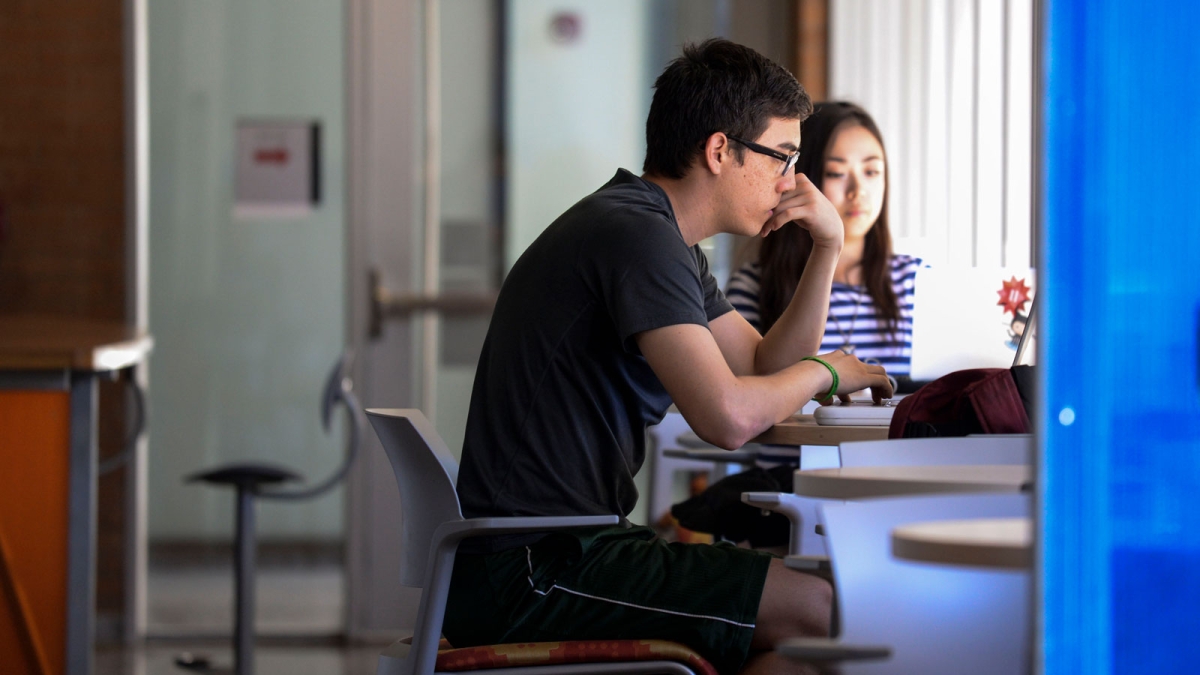A second chance at engineering leads to a lifetime of impact

Students study intently at the ECG Student Center on the Arizona State University Tempe campus. Learning how to maintain a work-school balance was the key to success for JR Frey (not pictured) when he was studying engineering at ASU. Photographer: Hayden Taylor/ASU
Engineering is a rewarding career, but reaping the benefits requires sowing discipline and good habits — and knowing when to ask for help.
When JR Frey started studying civil engineering at Arizona State University in 1993, before the engineering school was named the Ira A. Fulton Schools of Engineering, he didn’t quite get off on the right foot.
“I worked my way through school for the most part, so there were times when I was working full time while I was trying to take a full course load, and that didn’t always work,” Frey said.
Because the engineering firm where Frey worked provided him with relevant experience for his future career, taking the necessary steps to get his degree became less of a priority for him and his grades began to suffer.
It was then Frey realized he needed to change his approach in school.
Getting on the right path
“My GPA dipped below what was acceptable for the school of engineering at the time, but it didn’t dip so far that I was ineligible to be at ASU,” Frey said. “At that point, I took that opportunity to methodically work to improve my GPA and get back into the school of engineering.”
During the time he was not in an engineering program, Frey took classes such as physical chemistry and organic chemistry, which were applicable to his major as technical electives and would help elevate his GPA.
“Throughout the process, the administration and faculty were very supportive,” Frey said. “They were always open to bringing somebody back in. If for whatever reason, you were out (of the program), there wasn’t any judgment about what you had done before, it’s what are you going to do now and what are you going to do going forward.”
After taking physical chemistry, Frey’s GPA rose high enough for him to return to the engineering school to complete studies for his degree. It was then he decided to reconsider working full time.
“Once I was readmitted, I actually resigned from the engineering job that I had because I had too much responsibility and too much on my plate,” he said. “I took a job with another engineering firm where I had very limited responsibilities and that allowed me to focus more on completing studies for my degree.”
Though he knew he was gaining invaluable experience at his job, Frey made the decision to prioritize his schoolwork, as obtaining his degree was a prerequisite for the professional career he wanted.
Hard work gains new skills

Fall River city engineer JR Frey with his daughters, Charlotte and Vivienne. Photo by Jack Foley/Herald News
The process of improving his GPA enough to get back into the civil engineering program was arduous. While engineering concepts always came easily to Frey, knowing how to study did not.
“I had to learn a lot of study habits and work habits that I didn’t learn in high school, and that came back to haunt me early on,” Frey said. “So, there was that part of that whole learning experience as well.”
Much of the difficulty for Frey, who had background knowledge of civil engineering from his work experiences, was putting in the time and effort necessary to demonstrate subject mastery of his classes. While he strove to apply himself to his career, he first needed to learn how to apply himself to his classes.
First, Frey chose classes that were of interest to him. After that, it was taking a methodical approach to complete all the requirements for the course and eventually earn his degree.
Once he began the next phase of his career, Frey found parallels between his time as a student and what he was doing in the workplace. The skills Frey gained while he was learning to be an effective engineering student transferred into his career in civil engineering.
“If you’re going into civil engineering, you’re going to find the regulations that are applicable to the project that you’re working on and you’re going to check the boxes. And that’s not always the most fun part of the job, but it’s a necessary part of the job.”
Frey earned his degree from ASU in 1999. He now serves the people of Fall River, Massachusetts, as a city engineer, after working jobs in municipal utilities and in consulting.
What Frey said ultimately made him a good engineer was getting past the tendency to rely solely on his existing knowledge and instead summoning the dedication to complete tasks to the fullest extent.
“You want people who can be dedicated to the craft, who are going to work for it and are going to put in the time and the effort,” he said. “You don’t want engineers who aren’t willing to put in the time and the effort. The work requires some dedication.”
Talent can get you far, but Frey says it’s the hard work that gets you the farthest.
“You can be the smartest person in the world, but it ends up being about the effort you put in. And I had to be willing to commit and make that effort for the degree and not just for other areas of my life even if they were related to engineering.”
Students with a full or difficult class schedule can take comfort in knowing that there are on-campus resources available to them, such as office hours, tutoring and academic advising. Actively working toward the goal of graduation and being able to ask for help along the way are both key parts to being successful in school and in your career.
More Science and technology

Brilliant move: Mathematician’s latest gambit is new chess AI
Benjamin Franklin wrote a book about chess. Napoleon spent his post-Waterloo years in exile playing the game on St. Helena. John…

ASU team studying radiation-resistant stem cells that could protect astronauts in space
It’s 2038.A group of NASA astronauts headed for Mars on a six-month scientific mission carry with them personalized stem cell…
Largest genetic chimpanzee study unveils how they’ve adapted to multiple habitats and disease
Chimpanzees are humans' closest living relatives, sharing about 98% of our DNA. Because of this, scientists can learn more about…